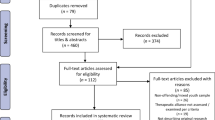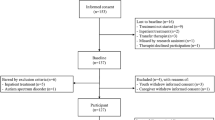Abstract
The perceived quality of the working alliance in psychotherapy has been a consistent predictor of engagement and outcome in adult psychotherapy, yet there is limited research on working alliance in youth psychotherapy, particularly in the context of “usual” community-based services. In this study, we examined working alliance among 78 adolescents referred for community-based psychotherapy, their parents and therapists. We investigated (1) temporal stability of alliance from 1 to 6 months into treatment, (2) consistency among adolescent, parent, and therapist reports of alliances, and (3) associations between alliance and four outcome domains: symptoms, functioning, satisfaction, and environmental impact. We found individual reports of alliance relatively stable from 1 to 6 months into treatment, but consistency among reporters on quality of their alliance was low. We also found adolescent and parent reported alliances with therapists to be positively associated with several outcome indicators.
Similar content being viewed by others
Notes
Although these participants may be unique in some way from those who had not begun therapy at the time of the baseline interview, they did not differ from the larger sample on age, gender, race/ethnicity, or initial problem severity.
References
Achenbach, T. M., & Edelbrock, C. S. (1991a). Manual for the youth self report form and 1991 profile. Burlington, VT: Department of Psychiatry, University of Vermont.
Achenbach, T. M., & Edelbrock, C. S. (1991b). Manual for the child behavior checklist/4-18 and 1991 profile. Burlington, VT: Department of Psychiatry, University of Vermont.
Anehensel, C. S., & Stone, J. D. (1982). Stress and depression: A test of the buffering model of social support. Archives of General Psychiatry, 39, 1392–1396.
Baker, M., Miller, B., Ganger, W., Wilhite-Grow, D., Mueggenborg, M. G., & Zhang, J. (2003). Children’s mental health services: Fourth annual system of care report. Published by County of San Diego Health & Human Services Agency.
Bickman, L., Lambert, E. W., Karver, M., & Andrade, A. R. (1998). Two low-cost measures of child and adolescent functioning for services research. Evaluation and Program Planning, 21, 263–275.
Bickman, L., Rosof-Williams, J., Salzer, M. S., Summerfelt, T., Noser, K., Wilson, S. J., & Karver, M. S. (2000). What information do clinicians value for monitoring client progress and outcomes? Professional Psychology: Research and Practice, 31, 70–74.
Bird, H. R., Yager, T. J., Staghezza, B., Gould, M. S., et al. (1990). Impairment in the epidemiological measurement of childhood psychopathology in the community. Journal of the American Academy of Child and Adolescent Psychiatry, 29, 796–803.
Bordin, E. S. (1979). The generalizability of the psychoanalytic concept of the working alliance. Psychotherapy: Theory, Research and Practice, 16, 252–260.
Compas, B. E., Davies, G. E., Forsythe, C. J., & Wagner, B. M. (1987). Assessment of major and daily stressful events during adolescence: The Adolescent Perceived Events Scale. Journal of Consulting and Clinical Psychology, 55, 534–541.
D’Attilio, J. P., Campbell, B. M., Lubold, P., Jacobson, T., & Richard, J. A. (1992). Social support and suicide potential: Preliminary findings for adolescent populations. Psychological Reports, 70, 76–78.
Feeley, M., DeRubeis, R. J., & Gelfand, L. A. (1999). The temporal relation of adherence and alliance to symptom change in cognitive therapy for depression. Journal of Consulting and Clinical Psychology, 67, 578–582.
Garland, A. F., Kruse, M., & Aarons, G. (2003). Clinicians and outcome measurement: What’s the use? Journal of Behavioral Health Services & Research, 30, 393–405.
Garland, A. F., Lewczyk, C. M., Gabayan, E., & Hawley, K. M. (2004). Multiple stakeholder agreement on desired outcomes for adolescents’ mental health services. Psychiatric Services, 55, 671–676.
Garland, A. F., Saltzman, M., & Aarons, G. (2000). Adolescents’ satisfaction with mental health services: Development of a multi-dimensional scale. Evaluation and Program Planning, 23, 165–175.
Green, J., Kroll, L., Imrie, D., Frances, F. M., Begum, K., Harrison, L., & Anson, R. (2001). Health gain and outcome predictors during inpatient and related day treatment in child and adolescent psychiatry. Journal of the American Academy of Child and Adolescent Psychiatry, 40, 325–332.
Hawley, K. M., & Weisz, J. R. (2003). Child, parent, and therapist (dis)agreement on target problems in outpatient therapy: The therapist’s dilemma and its implications. Journal of Consulting and Clinical Psychology, 71, 62–70.
Hawley, K. M., & Weisz, J. R. (2005). Youth versus parent working alliance in usual clinical care: Distinctive associations with retention, satisfaction and treatment outcome. Journal of Clinical Child and Adolescent Psychology, 34, 117–128.
Hoge, R. D., Andrews, D. A., Faulkner, P., & Robinson, D. (1989). The Family Relationship Index: Validity data. Journal of Clinical Psychology, 45, 897–903.
Holahan, C. J., & Moos, R. H. (1983). The quality of social support: Measures of family and work relationships. British Journal of Clinical Psychology, 22, 157–162.
Horvath, A. O., & Greenberg, L. S. (1989). Development and validation of the Working Alliance Inventory. Journal of Counseling Psychology, 36, 223–233.
Horvath, A. O., & Luborsky, L. (1993). The role of the therapeutic alliance in psychotherapy. Special section: Curative factors in dynamic psychotherapy. Journal of Consulting and Clinical Psychology, 61, 561–573.
Horvath, A. O., & Symonds, B. D. (1991). Relation between working alliance and outcome in psychotherapy: A meta-analysis. Journal of Counseling Psychology, 38(2), 139–149.
Kazdin, A. E., Marciano, P. L., & Whitley, M. (2005). The therapeutic alliance in cognitive-behavioral treatment of children referred for oppositional, aggressive, and antisocial behavior. Journal of Consulting and Clinical Psychology, 73, 726–730.
Kazdin, A. E., Siegel, T. C., & Bass, D. (1990). Drawing on clinical practice to inform research on child and adolescent psychotherapy: Survey of practitioners. Professional Psychology: Research and Practice, 21, 189–198.
Kazdin, A. E., & Whitley, M., (2006) Child–therapist and parent–therapist alliance and therapeutic change in the treatment of children referred for oppositional, aggressive, and antisocial behavior. Journal of Consulting and Clinical Psychology, 74, 346–355.
Larsen, D. L., Attkisson, C. C., Hargreaves, W. A., & Nguyen, T. D. (1979). Assessment of client/patient satisfaction: Development of a general scale. Evaluation and Program Planning, 2, 197–207.
Martin, D. J., Garske, J. P., & Davis, M. K. (2000). Relation of the therapeutic alliance with outcome and other variables: A meta-analytic review. Journal of Consulting and Clinical Psychology, 68, 438–450.
McLeod, B. D., & Weisz, J. R. (2005). The therapy process observational coding system-alliance scale: Measure characteristics and prediction of outcome in usual clinical practice. Journal of Consulting & Clinical Psychology, 73, 323–333.
Noser, K., & Bickman, L. (2000). Quality indicators of children’s mental health services: Do they predict improved client outcomes? Journal of Emotional and Behavioral Disorders, 8, 9–18.
Raudenbush, S. W., & Bryk, A. S. (2002). Hierarchical linear models: Applications and data analysis methods, second edition. Newbury Park, CA: Sage.
Raudenbush, S. W., Bryk, A. S., Cheong, Y. F., Congdon, R. T., & du Toit, M. (2005). HLM 6: Hierarchical linear and nonlinear modeling. Lincolnwood, IL: Scientific Software International.
Rogers, C. R. (1957). The necessary and sufficient conditions of therapeutic personality change. Journal of Consulting Psychology, 21, 95–103.
Rosenberg, M. (1986). Conceiving the self. Malabar, FL: Krieger.
Rosenberg, M. (1989). Society and the adolescent self-image (revised edition). Middletown, CT: Wesleyan University Press.
Safren, S. A., & Heimberg, R. G. (1999). Depression, hopelessness, suicidality, and related factors in sexual minority and heterosexual adolescents. Journal of Consulting and Clinical Psychology, 67, 859–866.
Sarason, I. G., Levine, H. M., Basham, R. B., & Sarason, B. R. (1983). Assessing social support: The Social Support Questionnaire. Journal of Personality and Social Psychology, 44, 127–139.
Shaffer, D., Gould, M. S., Brasic, J., Ambrosini, P., Fisher, P., Bird, H., & Aluwahlia, S. (1983). A Children’s Global Assessment Scale (CGAS). Archives of General Psychiatry, 40, 1228–1231.
Shirk, S. R., & Karver, M. S. (2003). Prediction of treatment outcome from relationship variables in child and adolescent therapy: A meta-analytic review. Journal of Consulting and Clinical Psychology, 71, 452–464.
Shirk, S. R., & Saiz, C. C. (1992). Clinical, empirical, and developmental perspectives on the therapeutic relationship in child psychotherapy. Special Issue: Developmental approaches to prevention and intervention. Development and Psychopathology, 4, 713–728.
Stark, K. D., Rouse, L. W., & Livingston, R. (1991). Treatment of depression during childhood and adolescence: Cognitive-behavioral procedures for the individual and family. In: P. C. Kendall (Ed.), Child and adolescent therapy: Cognitive-behavioral procedures (pp. 165–206). New York: The Guilford Press.
Tang, T. Z., & DeRubeis, R. J. (1999). Sudden gains and critical sessions in cognitive-behavioral therapy for depression. Journal of Consulting and Clinical Psychology, 67, 894–904.
Tracey, T. J., & Kokotovic, A. M. (1989). Factor structure of the Working Alliance Inventory. Psychological Assessment, 1, 207–210.
Weersing, V. R., Weisz, J. R., & Donenberg, G. R. (2002). Development of the Therapy Procedures Checklist: A therapist-report measure of technique in child and adolescent treatment. Journal of Clinical Child Psychology, 31, 168–180.
Weisz, J. R., Huey, S. J., & Weersing, V. R. (1998). Psychotherapy outcome research with children and adolescents: The state of the art. Advances in Clinical Child Psychology, 20, 49–91.
Wintersteen, M. B., Mensinger, J. L., & Diamond, G. S. (2005). Do gender and racial differences between patient and therapist affect therapeutic alliance and treatment retention in adolescents? Professional Psychology: Research and Practice, 36, 400–408.
Acknowledgements
Preparation of this article was supported by NIMH Grants K01MH01544 and R01MH66070 (to AFG) and the San Diego State University Oscar Kaplan Postdoctoral Fellowship (to KMH). The study described here was approved by the Human Subjects Protection committees at the University of California, San Diego, Children’s Hospital of San Diego, and San Diego State University. We are grateful to Deb Dupuis, Erin Fuda, Elaine Gabayan, Bill Ganger, Caroline Lewczyk, and Sam Seljan for the important roles they played in this project. We would also like to thank the participating clinics, clinicians, and families, without whom this research would not have been possible.
Author information
Authors and Affiliations
Corresponding author
Rights and permissions
About this article
Cite this article
Hawley, K.M., Garland, A.F. Working Alliance in Adolescent Outpatient Therapy: Youth, Parent and Therapist Reports and Associations with Therapy Outcomes. Child Youth Care Forum 37, 59–74 (2008). https://doi.org/10.1007/s10566-008-9050-x
Received:
Accepted:
Published:
Issue Date:
DOI: https://doi.org/10.1007/s10566-008-9050-x




